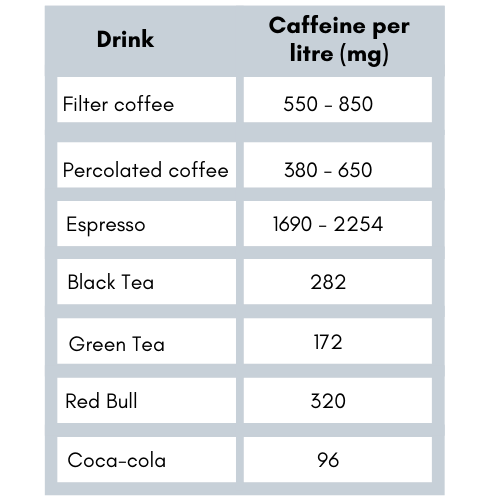When people think about their diet they nearly always focus on the food that they eat, and typically there is very little attention paid to the fluids they drink. In this article we will redress the balance and take a look at three liquids / substances that people interact with on a regular basis.
Water – everyone knows that water is an essential component of life. It is very clear that severe dehydration can seriously impact health, but too few people, with the exception of those in the sporting world, focus on optimal hydration as part of their wellbeing plan.
If someone is dehydrated by as little as 2%, mental productivity can fall by up to 8%; increase the dehydration level to 4% and the productivity loss will now stand at around 25%. At 5% people will start to make mistakes and experience symptoms such as headaches. It really doesn’t take too much of a drop for changes to performance and health to occur.
So how can you monitor your hydration level and how much water should you drink on a daily basis?
With regard to monitoring, one of the most effective ways is to check the colour of your urine. If it is darker than the palest shade of yellow, start hydrating. The only exception to this is if you are taking a vitamin B supplement. This is likely to contain riboflavin (B2) and this does result in a yellow pigmentation in urine.
As for the question of how much water should you drink a day – well the books may say 2 litres or 6 cups, but I want to suggest that we change our thinking on this and suggest that the correct answer is as much as you need. On a hot day you will potentially need more than on a cold day; if you have done some exertional exercise and sweated, then you will need to take on board more fluid. You are the dynamic part of the equation, evaluate what you have been doing and how you are feeling and hydrate appropriately. Equally, the mantra ‘if in doubt, drink’ is also useful to follow!
Caffeine
The message on caffeine is a slightly mixed one. There is some good early stage evidence to show that controlled caffeine intake, in healthy individuals, can reduce the risk of cardiovascular disease by 15% and late life dementia by 65%. However, we should balance this by recognising that caffeine, through its inhibition of adenosine, is a stimulant that can interfere with the quality of our sleep. Adenosine is a substance that builds up as the day progresses and through its inhibitory action, it reduces the feeling of wakefulness. Caffeine does pretty much the opposite – if it is present in significant levels it will override the action of adenosine and make us feel alert, useful at times, but maybe not so if we are just about to go to bed.
We often don’t realise how much caffeine there is in our drinks (the following table may help) and there is not a government guideline on weekly caffeine intake, in the same way that advice is given on alcohol consumption (The Mayo Clinic suggests up to 400mg caffeine per day). One of the real challenges that caffeine presents is its chemistry and in particular the fact that it has a half-life of around 5 hours – this means that if you have a large filter coffee at around 5 p.m. five hours later, at 10 p.m. you would still have around 150mg of a stimulant disrupting the calming action of adenosine. The important things to consider are dosage and timing.

Alcohol
Contrary to popular belief, alcohol is a depressant of the central nervous system. One of the first parts of the brain that it depresses is our inhibition centre, which is why people may initially become louder and more gregarious. Drink more and parts of the brain associated with speech and co-ordination are affected and people may start to slur their speech and lose their co-ordination. The significant consequences of being ‘drunk’ are known to most, however it is some of the impacts that arise with lesser amounts of alcohol that are not. One of the biggest challenges that alcohol presents is that the quality of our sleep can be impacted. The graph below shows heart rate variability data from the same person on two consecutive 24 hour periods. This is complex physiology but in simple terms, the red colour indicates when the body is under load (some people will call this stress or pressure, and this is very typical during the working day), the dark blue depicts physical activity and the turquoise colour signifies physiological recovery. On day 1 the person drinks no alcohol and on day two they take clients out for dinner and self-estimated that they drank 6 units. The person went to bed at the same time on both nights, but it is clear to see that on the second night that, whilst asleep, they were not recharging effectively.
Day 1

Day 2

The fluids we take on board may differ in taste, colour and consistency; they also vary in how they affect our ability to function effectively and be healthy. I drink water (not enough), and interact with both caffeine (probably more than I should) and alcohol (in moderation). The key point is to be more mindful around what the food and, in this case the drinks that make up our typical diet, do to us.
